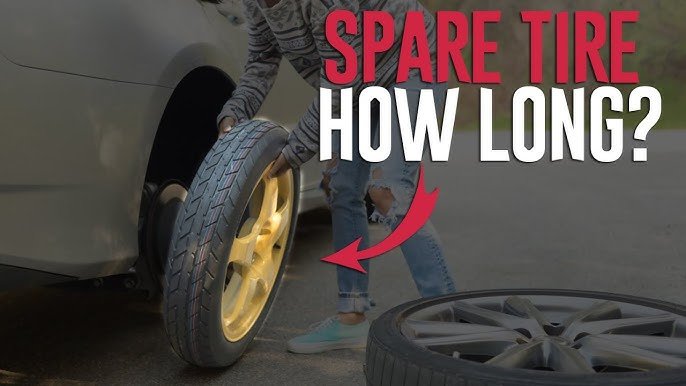Flat tires are one of those road problems that seem to happen at the worst possible time. You’re heading to work, running errands, or driving late at night, when suddenly you hear the dreaded thump-thump-thump of a flat. You pull over, open your trunk, and grab the spare tire. Relief washes over you as you get back on the road. But then another thought pops into your head: how long can you drive on a spare tire before it becomes unsafe?
This isn’t a trivial question. Spare tires come in different types, each with its own limitations. Some can get you safely across town, while others can keep you going for weeks if properly maintained. Pushing them beyond their intended use can damage your car and put you at risk.
In this comprehensive guide, we’ll cover:
- The different types of spare tires and how far each can safely go.
- The factors that affect spare tire lifespan.
- The dangers of driving too long on a spare.
- Practical safety tips for when you’re forced to use one.
- Maintenance and replacement guidelines so you’re never caught off guard.
By the end, you’ll know exactly what to do if you find yourself driving on a spare, whether it’s a tiny donut tire or a full-size backup.
How Long Can You Drive?
The answer depends on what kind of spare you have. Here’s the general breakdown:
- Donut spare tires: Safe for 50–70 miles at speeds up to 50 mph.
- Full size spare tires: Can last hundreds or even thousands of miles if they’re new and well-maintained, though they shouldn’t replace a proper tire long-term.
- Run flat tires: Can go about 50 miles at 50 mph, even after losing air pressure.
The golden rule is this: a spare is meant to get you home or to a repair shop, not to serve as a permanent replacement.
Why Do Spare Tires Have Limits?
Spare tires are built for emergencies, not endurance. Donuts, in particular, are made smaller and lighter to save trunk space and cost. That means:
- Thinner tread less grip on the road.
- Smaller size uneven wear compared to other tires.
- Weaker sidewalls more prone to blowouts.
Even a full-size spare that looks identical to your regular tires might have an older manufacture date or different tread pattern, which can affect handling.
Types of Spare Tires and Their Lifespan
Let’s break down the main types of spares you might find in your car.
Temporary “Donut” Spare Tires
Donuts are compact, lightweight, and designed only to get you out of an emergency.
- Distance: 50 70 miles
- Speed: 50 mph maximum
- Best use case: Driving from the roadside to the nearest repair shop
Donuts are smaller than your regular tires, which makes your car sit unevenly. That puts stress on your suspension, transmission, and braking system.
Example:
A driver in Texas was stranded 20 miles from a repair shop. He used his donut and made it safely, but then decided to drive another 100 miles to save money on a tow. By the end of the trip, his brake pads were worn unevenly, and the spare shredded on the highway. The final repair bill was nearly $800 much more than the cost of a new tire.
Full Size Spare Tires
Full size spares are the closest thing to having an extra regular tire.
- Distance: Hundreds to thousands of miles if properly stored
- Speed: Normal driving speeds (if the spare matches your tire set)
- Best use case: Temporary replacement until you buy a new tire
These spares are common in SUVs and trucks, but less common in compact cars today. The catch is that if they’re not rotated regularly, a full-size spare may have a completely different tread depth than the other three tires, which can affect traction and wear.
Run Flat Tires
Run-flats are modern alternatives that let you drive even after a puncture.
- Distance: 50 miles on average
- Speed: Up to 50 mph
- Best use case: Short commutes to the repair shop without changing a tire roadside
Run-flats are popular in high-end vehicles, but they come with drawbacks. They’re expensive, ride stiffer than normal tires, and once damaged, they usually need replacement rather than repair.
Quick Comparison Chart
| Spare Tire Type | Average Distance | Speed Limit | Durability | Best Use Case |
| Donut Spare | 50–70 miles | 50 mph | Low | Emergency only |
| Full-Size Spare | 1000+ miles | Normal | High | Long-term backup |
| Run-Flat Tire | ~50 miles | 50 mph | Medium | Short commutes |
Factors That Affect How Long You
Even with general mileage guidelines, several real world factors determine how long your spare will last.
- Speed
- Driving over 50 mph on a donut drastically increases the risk of a blowout.
- Full-size spares are more forgiving, but speed still creates extra heat and wear.
- Distance
- Short city drives are less stressful than long highway trips.
- A donut might last 70 miles in town but fail after 40 miles of continuous highway driving.
- Weather Conditions
- Heat softens rubber and can cause premature wear.
- Rain or snow reduces traction on already limited tread.
- Vehicle Weight
- Heavier vehicles like trucks or SUVs wear out spares faster.
- Compact cars put less strain on temporary tires.
- Age and Storage
- A spare that’s been sitting in your trunk for 10 years may look fine but could have dry rot or cracks in the rubber.
Statistic: According to AAA, nearly 60% of spares checked during roadside calls were either flat, aged, or otherwise unsafe.
The Dangers of Driving Too Long on a Spare Tire
You might think you’re saving time or money by stretching a spare’s use, but the risks are serious.
- Reduced traction: Donuts have less tread, making hydroplaning more likely.
- Poor handling: Your car may pull to one side or feel unstable.
- Increased braking distance: Smaller surface area reduces stopping power.
- Mechanical damage: Uneven tire sizes strain the transmission and suspension.
- Tire failure: Blowouts are common if spares are pushed too far.
Quote from a mechanic:
“A spare tire is a Band-Aid, not a cure. You can’t run a marathon on crutches.”
Tips for Safely Driving
When you’re forced to rely on a spare, these steps keep you safe:
- Check air pressure before driving off. Donuts often sit underinflated in the trunk.
- Keep speeds low 50 mph or less for donuts and run-flats.
- Drive only as far as necessary. Head straight to a tire shop.
- Avoid heavy loads. Don’t tow or carry extra weight on a spare.
- Drive gently. No hard braking, quick acceleration, or sharp turns.
How to Extend
Even if you rarely use your spare, proper maintenance ensures it’s ready when you need it.
- Inspect yearly: Look for cracks, bulges, or dry rot.
- Keep it inflated: Check pressure every 6 months.
- Store it properly: Keep it away from direct sunlight or heat.
- Rotate full size spares: Include them in your normal tire rotation schedule.
Pro Tip: A neglected spare is just dead weight in your trunk. Treat it like your regular tires, and it’ll save you when you need it most.
When to Replace
Even unused spares don’t last forever. Rubber degrades with time.
- Replace every 6 10 years, regardless of tread condition.
- Check tread depth less than 2/32 inch is unsafe.
- Look for damage: Cracks, bulges, and flat spots mean replacement is overdue.
How to tell the age of your tire:
Examine the sidewall’s imprinted DOT code.The last four digits indicate the week and year it was manufactured. For example, “2518” means the 25th week of 2018.
FAQs
Can you drive on the highway with a spare tire?
Yes, but only with a full-size spare. Donuts are not recommended for highway use.
With a donut spare, how fast can you drive?
No more than 50 mph. Going faster increases the risk of failure.
Do all cars come with a spare tire?
No. Many newer vehicles come with tire repair kits or run-flats instead. Always check before buying a used car.
How much does a spare tire cost?
- Donut spares: $100 $200
- Full size spares: $300+
- Run flats: $200 $500 each
Can you repair a spare tire if it gets punctured?
- Donuts: No, they should be replaced.
- Full size: Yes, if damage is minor.
- Run flats: Often require full replacement.
Real World Example: A Tale of Two Drivers
Driver A: Sarah got a flat on her way home. She used her donut and immediately drove 15 miles to the nearest tire shop. Her spare worked perfectly, and she replaced her damaged tire the same day.
Driver B: Mike used his donut to drive over 100 miles across state lines to save money. His spare blew out on the highway, damaging his wheel and suspension. His total bill was over $1,200.
Lesson: Don’t gamble with your spare. Use it responsibly, and it’ll save you. Misuse it, and you could face expensive consequences.
Conclusion
How long is it possible to drive on a spare tire?
- Donut spare: 50 70 miles at speeds under 50 mph.
- Full size spare: Much longer, potentially thousands of miles, but still temporary.
- Run flat tire: Around 50 miles at reduced speed.
The most important thing is to treat your spare as an emergency tool, not a replacement. Driving too long on one risks safety, damages your vehicle, and can cost you far more than a proper repair.



